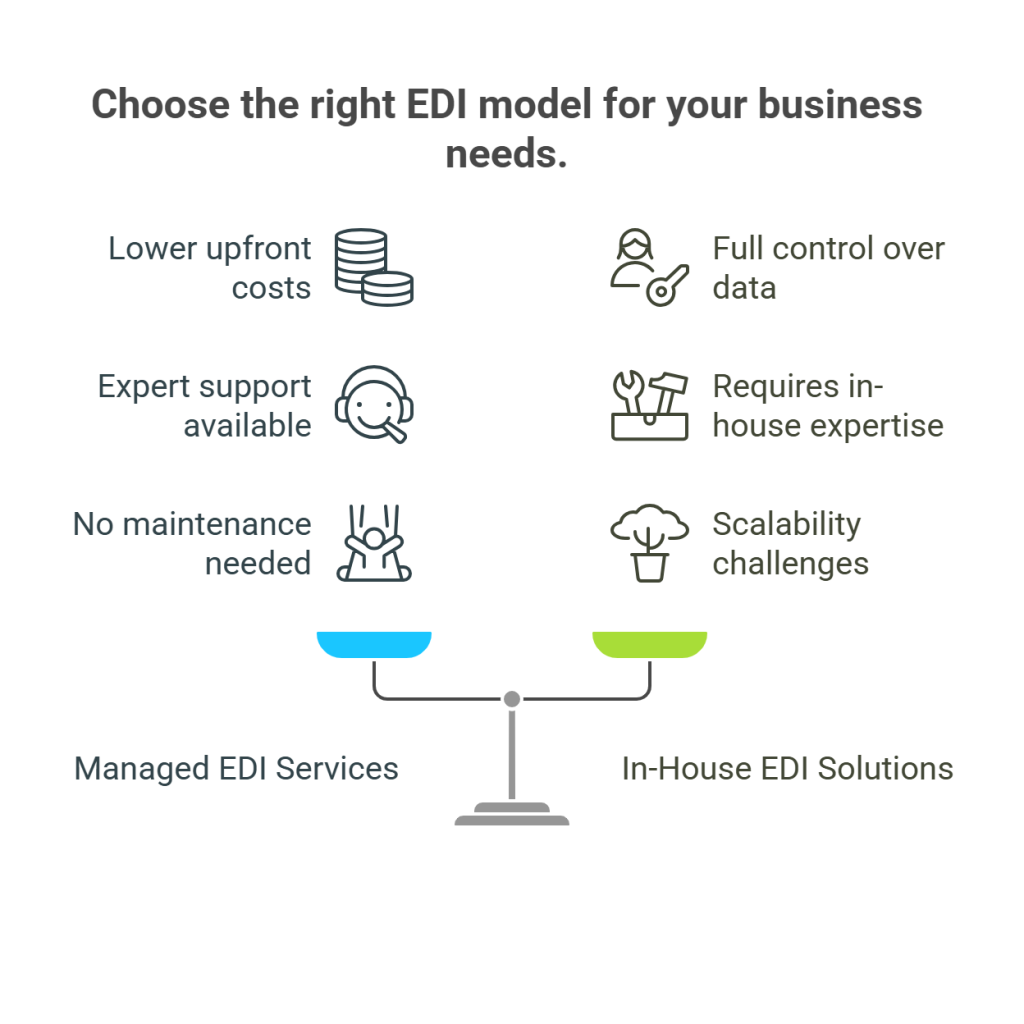Introduction
EDI services have transformed supply chains. These systems cut transaction processing times from weeks to just minutes or hours.
We’ve witnessed how Electronic Data Interchange (EDI) improves efficiency in supply chain operations through instant data transmission between systems.
Today’s market shows that 90% of retailers need their vendors to be EDI-compliant before doing business with them.
EDI’s role in supply chain management is straightforward. It provides a standard way for business partners to exchange documents electronically.
This eliminates manual data entry that slows down operations and creates errors. EDI in supply chain operations speeds up b2b document exchange by 60%. It helps solve common logistics problems like delivery delays and broken communication channels. EDI’s benefits go beyond speed.
These systems result in better inventory management, lower operational costs, and smarter decision-making that helps businesses keep up with market trends.
Why Supply Chain Efficiency Matters Today

Companies save money and keep their customers happy through quicker processing, better inventory control, and speedier delivery when they optimize their supply chains. This excellence in operations leads straight to bigger profits and a competitive edge.
1. Challenges in Modern Supply Chains
Supply chains today face disruptions that put their resilience to the test. A December 2022 survey showed that 61% of logistics managers said their supply chains weren’t working normally. About 29% didn’t expect things to get back to normal until at least 2025 – if ever. The global marketplace brings risks from cyberattacks, labor strikes, supplier bankruptcies, and climate emergencies. The biggest problem for 84% of chief supply chain officers is poor visibility, which creates waste and inefficiency throughout their operations.
2. The Role of Digital Transformation
Digital transformation means more than just going digital – it’s a complete overhaul of processes powered by groundbreaking technologies. The trend toward transformation is clear, with 82% of CEOs in supply-chain-heavy industries planning to invest more in digital capabilities. Digital solutions give up-to-the-minute visibility into every part of the supply chain. This helps leaders make better decisions through predictive analytics and AI-powered insights. Operations become more synchronized and flexible, ready to respond faster to disruptions.
3. Where Traditional Systems Fall Short
Traditional supply chain systems react based on past transactions instead of current data. These systems work in isolation with minimal data sharing, which makes coordination hard and optimization almost impossible. Legacy approaches can’t quickly spot problems along the value chain. Finding solutions and predicting effects takes too much time and effort when issues come up. This slows production, creates errors, and increases time-to-market. These limitations explain why EDI services are essential for businesses that want to move beyond traditional approaches.
How EDI transforms supply chain operations

Electronic Data Interchange serves as a digital messenger at the core of modern supply chains. It revolutionizes how businesses exchange critical information. Traditional paper-based methods have given way to EDI services that create a standardized electronic language between trading partners to improve operational efficiency.
1. Automating Document Exchange
EDI converts business documents into standardized digital formats through a three-step cycle. The sender’s system translates documents into EDI format. These documents travel securely to the recipient. The recipient’s system converts them back into a compatible format for immediate processing. This automation eliminates paper-based processes that once required printing, mailing, and manual handling of essential documents like purchase orders, invoices, and shipping notices.
2. Reducing Manual Work and Human Error
One of the biggest advantages of EDI in the supply chain comes from error reduction. Studies show that up to 5% of all manually entered invoice data contains typing errors. EDI services eliminate these mistakes by removing human intervention from the process. As a result, businesses face fewer returned orders, disputes, and delays, which builds stronger trust between trading partners. Staff members can now focus on higher-value activities instead of routine data entry tasks. In fact, in one of our recent case studies, our client saved 100’s of hours of manual work by switching to Commport EDI solutions.
3. Speeding Up Communication Between Partners
EDI’s speed advantage in supply chain management stands out remarkably. Traditional paper-based processes could take days or weeks, but EDI transactions complete in minutes or hours. This quick communication gives all supply chain partners up-to-date information about orders, inventory levels, and shipment statuses.
Live visibility enables:
- Faster order fulfillment and reduced procurement delays
- Immediate inventory updates prevent stockouts and overstocking
- Proactive responses to potential supply chain disruptions
EDI creates a synchronized digital ecosystem where information flows smoothly between systems. This uninterrupted connectivity helps businesses process transactions faster, improve forecasting accuracy, and maintain better relationships with trading partners. The entire supply chain becomes a more efficient, responsive operation.
Modern EDI solutions and service models

Businesses today must decide how they want to implement their EDI capabilities. They can choose from several service models, and picking the right one can affect their operational efficiency and budget by a lot.
What are Managed EDI Services?
Managed EDI services let you hand over your EDI operations to specialized third-party providers. These providers take care of everything from setup and integration to maintenance and support. Unlike simple EDI solutions, managed services handle technical configuration, data validation, and keep watch over your EDI ecosystem. They work like expert translators who transform data and fix issues. This lets your team concentrate on what matters most – running your business.
Benefits of Fully Managed EDI Services
Fully managed EDI services offer much more value than simple outsourced solutions. Companies that use these services cut their document processing time by 70-90% compared to manual methods. The cost of an invoice drops from $27 to just $1, which can save companies around $117,000 each year. These providers also handle important tasks that other “managed” solutions often skip:
- Partner onboarding with dedicated integration engineers
- Active 24/7 message monitoring and error fixes
- Immediate updates on transaction status
Cloud-Based vs On-Premise EDI
Cloud-based EDI runs through web-based systems that service providers host, with no need for on-site hardware. This cuts upfront costs, removes maintenance duties, and grows naturally with your business. On-premise EDI, however, runs on your servers and software. It gives you total control but needs a heavy investment in infrastructure and expertise.
Choosing Between B2B EDI Services and In-house Solutions
Your choice between outsourcing and managing EDI in-house depends on your budget, team expertise, and how much control you want. Companies without EDI specialists can benefit right away by partnering with an experienced provider like Commport Communications.
Switch to Commport Communications Today. A Leading EDI Service Provider in North America offers Integrated EDI, Cloud EDI, and EDI outsourcing solutions to eliminate manual processes. Improve your supply chain efficiency and provide expert support throughout your integration.
List of EDI Services Offered by Commport Communications
EDI Integration Services
- Seamless integration of EDI with ERP, WMS, TMS, accounting software (e.g., SAP, NetSuite, Microsoft Dynamics)
- API and flat file mapping
- Custom middleware and connector development
Cloud EDI / Web-Based EDI
- Web EDI portals for small-to-medium trading partners
- Browser-based EDI platforms for easy document exchange
- No on-premise software required
Integrated EDI
- EDI for enterprise trading partners
- Supports large volumes of data processing
- Direct integration with all major ERPs & other backend systems
Managed EDI Services (EDI Outsourcing)
- Full-service EDI management (monitoring, error resolution, partner onboarding)
- 24/7 support and maintenance
- SLA-based service delivery
Value-Added Network (VAN) Services
- Secure communication and routing of EDI documents via value added network
- Interconnectivity with global trading partners
- Mailbox services for EDI transmission
EDI Mapping and Translation
- Mapping EDI formats (X12, EDIFACT, TRADACOMS, XML, CSV, etc.)
- Translation between EDI and internal file formats (flat file, JSON, etc.)
- Custom map development and testing
7. EDI Compliance and Testing Services
- Ensuring compliance with trading partner requirements
- AS2, SFTP, HTTPS, and VAN protocol testing
- Pre-certification and partner-specific onboarding
8. EDI Onboarding Services
- Fast onboarding of new trading partners
- Custom integration workflows
- Partner-specific document testing and setup
Real-Time EDI Monitoring & Reporting
- Dashboard for monitoring document flows
- Real-time alerts and error notifications
- Detailed audit logs and analytics
Document Management & Archiving
- Secure storage of EDI transactions
- Retrieval, filtering, and export features
- Audit readiness and data retention compliance
Support for Multiple EDI Standards
- ANSI X12 (North America)
- EDIFACT (Europe/Global)
- TRADACOMS (UK)
- HL7 (Healthcare)
- RosettaNet (High Tech)
- VICS, EANCOM, etc.
Custom EDI Development Services
- Tailored solutions for unique workflows
- Integration with legacy systems
- Custom dashboards or portals
EDI Consulting Services
- EDI strategy and assessment
- Migration from legacy EDI platforms
- Scalability and performance planning
Strategic Advantages of EDI Adoption

EDI services create lasting business value throughout the supply chain. These services do more than automate document exchange. Companies that implement these solutions get a competitive edge through improved data intelligence and simplified partner coordination.
1. Improved Forecasting and Demand Planning
EDI solutions update vital data like orders, shipping details, and returns immediately. This gives businesses applicable information they can use to forecast demand. Retailers can spot fast-selling products and adjust their inventory accordingly. This prevents both stockouts and overstocking situations. EDI inventory management collects sales data in real time so businesses learn about customer demand patterns and seasonal changes. Production schedules can then be arranged with projected sales forecasts. This reduces guesswork and supports analytical insights for inventory planning.
2. Better Trading Partner Relationships
EDI creates clear, traceable records of all transactions across the business ecosystem. This encourages trust and accountability. The system speeds up communication and cuts down errors by removing manual data entry. This helps businesses stay in sync with their partners. These improvements lead to stronger collaboration. Partners can focus on strategic plans instead of paperwork. They learn about opportunities for innovation and ways to reduce costs. Research shows that EDI technology builds stronger trading partnerships. It encourages shared knowledge and collaborative problem-solving that propels development.
3. Scalability and global reach
EDI has evolved to offer flexible solutions that grow with businesses, even though it’s a veteran B2B technology. Modern EDI works with various formats, protocols, and integrations via API, making it highly adaptable. The core capabilities include:
- Extensive support for standards like EDIFACT, VDA, TRADACOMS, and PEPPOL
- Compatibility with multiple file transfer protocols, including OFTP2, AS2, and SFTP
- Value-added networks (VANs) that help access numerous trading partners through a single connection
4. Stronger Compliance and Audit Readiness
EDI compliance matters in today’s digital world. It helps meet commitments and maintain business relationships. Organizations with proper EDI implementation save money by simplifying documentation. This leads to fewer violations and supply chain delays. All the same, EDI’s security protocols protect sensitive data during exchanges. This ensures confidentiality and integrity in transactions. EDI systems keep detailed logs and audit trails. These ensure transparency and allow complete tracking of all business exchanges.
Conclusion
Electronic Data Interchange has revolutionized modern supply chains by turning slow, error-prone operations into agile, responsive systems. EDI services remove manual processes, cut down human errors, and speed up partner communications. These changes ended up creating huge cost savings and better efficiency. Supply chain businesses that use EDI solutions also see better inventory management, improved forecasting, and stronger bonds with trading partners.
EDI’s benefits are way beyond the reach and influence of simple document exchange. Companies that use these systems get a valuable edge over competitors through up-to-the-minute data visibility. This helps them make faster, smarter decisions that affect their bottom line. Supply chain organizations should assess which EDI service model lines up with their business needs and goals.
Picking the right EDI solution needs you to think over several factors. Many supply chain leaders find that fully managed services give them the best mix of expertise, support, and economical solutions. Switch to Commport Communications Today. Leading EDI Service Provider in North America offering a wide range of EDI solutions and services with detailed implementation help and ongoing support that cuts disruption while boosting investment returns.
EDI is more than just a tech upgrade – it’s a fundamental change in supply chain management approach. Setting it up needs careful planning and partner coordination. The long-term payoff includes lower costs, fewer errors, and better partner relationships. These benefits make the investment worthwhile. Companies that welcome EDI now build greater resilience against future disruptions. They also create foundations for continued development and breakthroughs in an increasingly digital supply chain world.
Commport EDI Solutions
Need Help? Download: Commport's EDI Buyers Guide
Unlock the full potential of your supply chain with our comprehensive EDI Buyer's Guide — your first step towards seamless, efficient, and error-free transactions
Frequently Asked Questions
EDI (Electronic Data Interchange) is a standardized method for businesses to exchange documents electronically. It enhances supply chain efficiency by automating document exchange, reducing manual work and errors, and speeding up communication between partners. This leads to faster order processing, improved inventory management, and reduced operational costs.
EDI transforms supply chains by converting business documents into standardized digital formats, eliminating paper-based processes. It automates data exchange, reducing manual entry errors and speeding up transactions from days to minutes. This real-time communication ensures all partners have up-to-date information, enabling faster order fulfillment and proactive responses to potential disruptions.
Fully managed EDI services offer significant advantages, including a 70-90% reduction in document processing time and potential annual savings of around $117,000. These services handle critical tasks such as partner onboarding, 24/7 message monitoring, error resolution, and provide real-time visibility into transaction status, allowing businesses to focus on core activities.
EDI solutions provide real-time updates on orders, shipping details, and returns, offering actionable intelligence for demand forecasting. This visibility allows businesses to identify fast-selling products, adjust inventory accordingly, and align production schedules with projected sales forecasts. It helps prevent stockouts and overstocking, leading to more accurate inventory management and demand planning.
EDI adoption offers several strategic advantages, including improved forecasting and demand planning, better trading partner relationships, scalability for global reach, and stronger compliance and audit readiness. It provides businesses with real-time data visibility for faster decision-making, reduces errors, speeds up communication, and fosters an environment of trust and accountability with trading partners.





